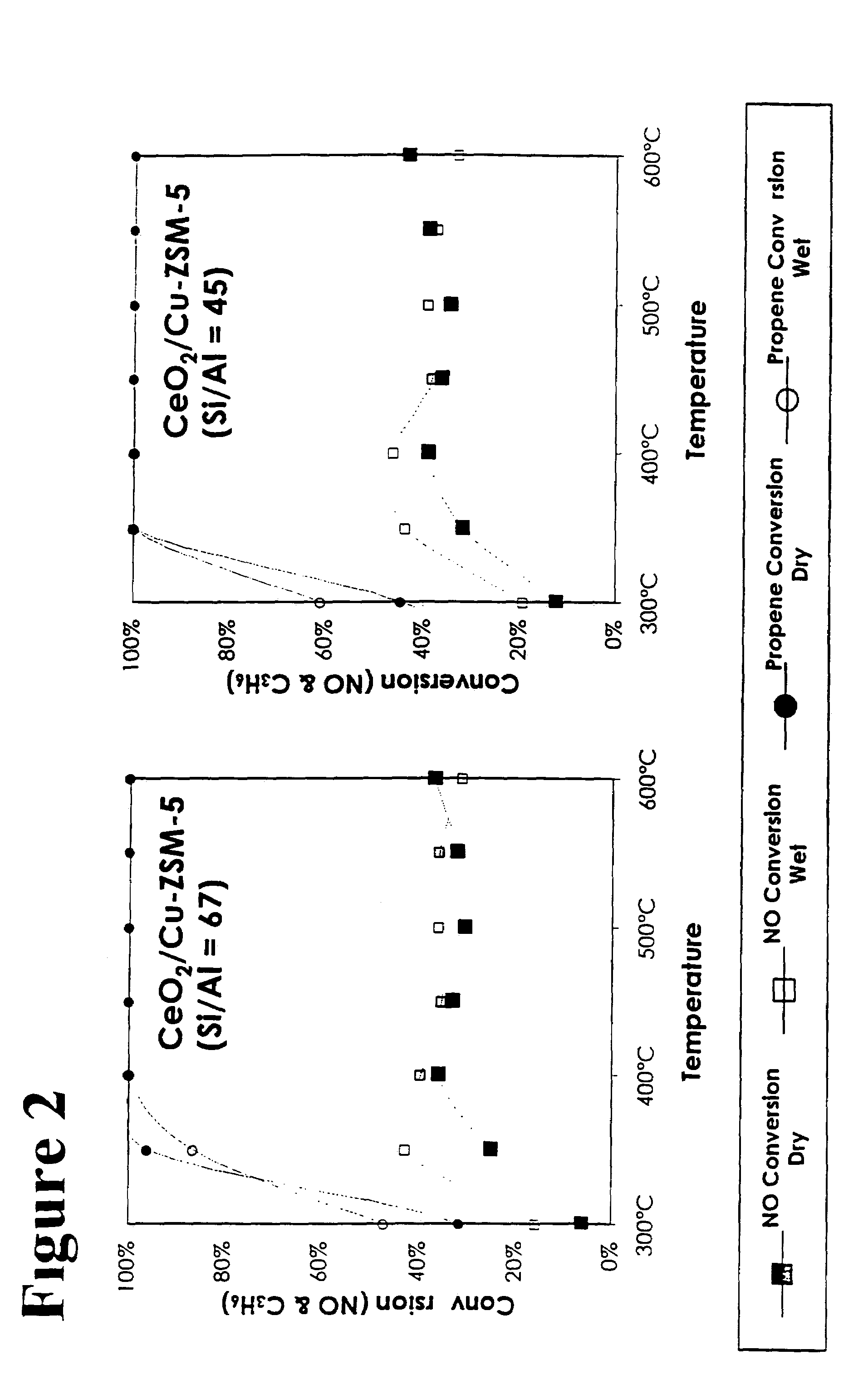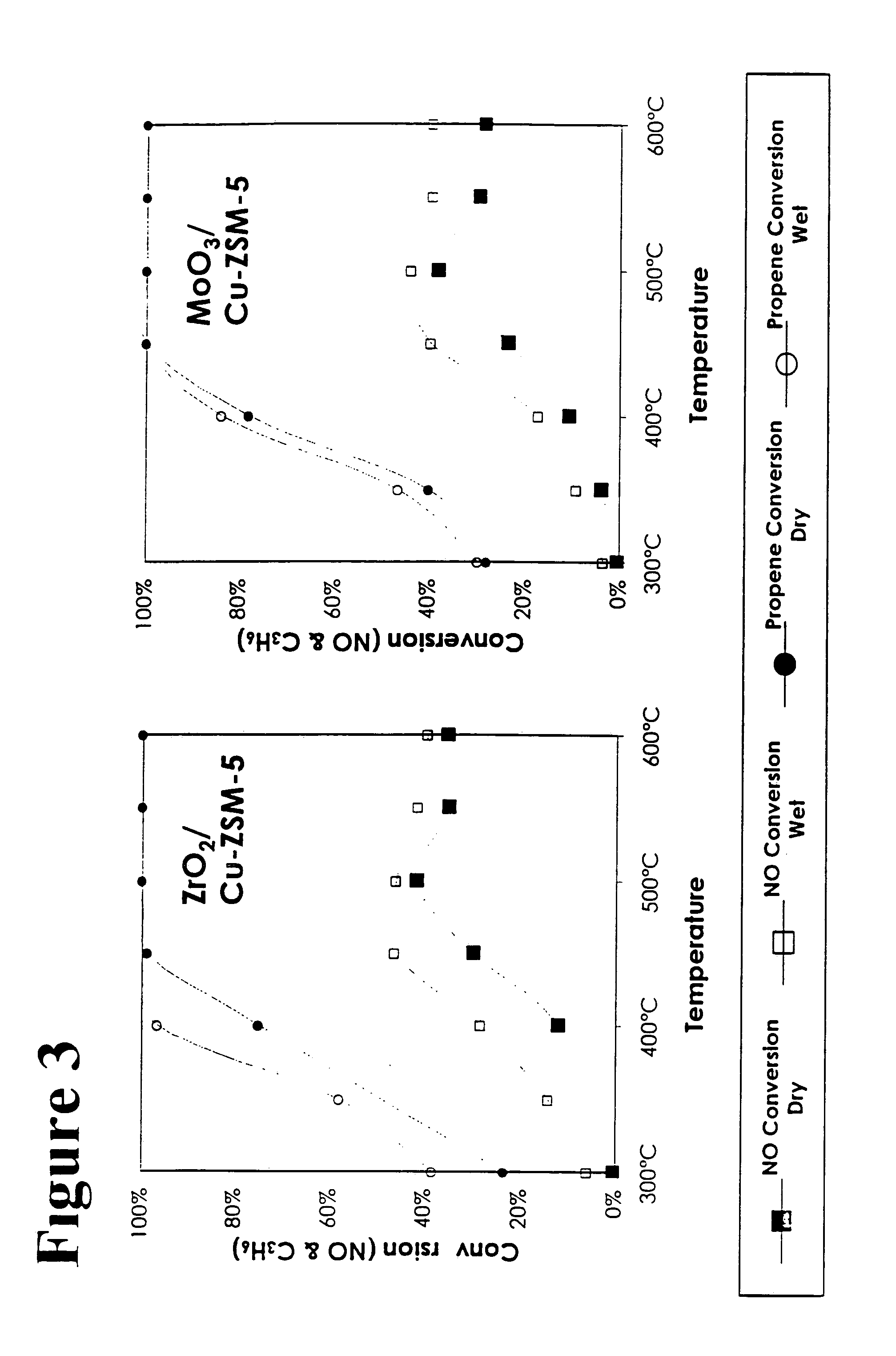Catalyst for selective NOx reduction using hydrocarbons
a technology of selective nox and catalyst, which is applied in the direction of physical/chemical process catalyst, dispersed particle separation, separation process, etc., can solve the problems of ineffective catalyst under lean-burn conditions, acid rain and detrimental interactions with ozone, and less desirable (especially in transportation systems)
- Summary
- Abstract
- Description
- Claims
- Application Information
AI Technical Summary
Benefits of technology
Problems solved by technology
Method used
Image
Examples
example 1
[0031]Preparation of CeO2 / Cu-ZSM-5: Copper was ion exchanged with a ZSM-5 zeolite via typical means. A 0.01 M solution of Cu(NO3)2 was prepared, and 2 g of H-ZSM-5 (SiO2 / Al2O3=80) was stirred into 40 ml of the solution. The slurry was stirred overnight at room temperature, then filtered, washed with distilled water, dried at 100° C. in a vacuum oven, then calcined in air at 500° C. for 3 hrs. Copper loadings can be adjusted by changing the concentration of the solution, the pH of mixing, or by repeated exchanges with the solution. Ceria was introduced by first diluting a ceria sol from 20 wt % to 0.01M. Two grams of the Cu-ZSM-5 was mixed with 40 ml of the ceria solution, and was stirred overnight at room temperature. The slurry was filtered, washed, dried, and then calcined using the same conditions above. This catalyst will be referred to as “CeO2 / Cu-ZSM-5”.
example 2
[0032]Preparation of Cu-ZSM-5 / CeO2: High surface area ceria was first prepared following traditional procedures. Five grams of cerium carbonate was slowly mixed with 4.5 ml of glacial acetic acid to produce cerium acetate. The sample was dried in a vacuum over at 100° C., the calcined in air at 425° C. to produce cerium oxide. The ceria was coated with a layer of Al2O3 to act as a template by mixing 2 g of the ceria with 40 ml of a 0.01M Al2O3 sol (diluted from a 20 wt % sol), stirring overnight, then filtering, washing, drying, and calcining in air at 500° C. as above. The zeolite precursor solution was prepared by mixing a solution containing NaOH, dissolved Al foil, and H2O with tetraethylorthosilicate (TEOS) and tetrapropylammonium hydroxide (TPAOH) such that the molar concentrations in the final solution was 4:0.06:571:6:1 NaOH:Al:H2O:TEOS:TPAOH. The solution was stirred at room temperature overnight, then approximately 40 ml was added to 2 g of the Al2O3 coated ceria in an aut...
example 3
[0033]In addition to the catalysts above, additional catalysts tested included: a Cu-ZSM-5 prepared similarly to CeO2 / Cu-ZSM-5 but without ceria addition, and a quantity of the Cu-ZSM-5 catalyst mixed in a equal weight ratio with the high surface area ceria prepared above. This latter catalyst was mixed by gentle grinding in a mortar for about 10 minutes.
PUM
| Property | Measurement | Unit |
|---|---|---|
| diameter | aaaaa | aaaaa |
| diameters | aaaaa | aaaaa |
| temperature | aaaaa | aaaaa |
Abstract
Description
Claims
Application Information
 Login to View More
Login to View More - R&D
- Intellectual Property
- Life Sciences
- Materials
- Tech Scout
- Unparalleled Data Quality
- Higher Quality Content
- 60% Fewer Hallucinations
Browse by: Latest US Patents, China's latest patents, Technical Efficacy Thesaurus, Application Domain, Technology Topic, Popular Technical Reports.
© 2025 PatSnap. All rights reserved.Legal|Privacy policy|Modern Slavery Act Transparency Statement|Sitemap|About US| Contact US: help@patsnap.com



